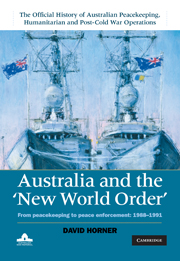Book contents
- Frontmatter
- Contents
- List of maps
- Preface
- Chronology 1987–91
- Abbreviations
- PART 1 STRATEGY AND POLICY
- PART 2 NEW MAJOR PEACE OPERATIONS
- 3 An international obligation
- 4 Establishing the force
- 5 Success in Namibia
- 6 Shadows from a distant war
- 7 A mission of presence
- 8 The genesis of humanitarian demining
- 9 Balancing the risks
- PART 3 THE FIRST GULF WAR
- Conclusion
- Appendix A Australian participation in multinational peacekeeping operations, 1947–2007
- Appendix B Key United Nations Security Council resolutions and statements
- Appendix C Investigations into chemical warfare in the Iran–Iraq War, 1984–87 by Daniel Flitton
- Appendix D Gulf War syndrome by Rosalind Hearder
- Appendix E Major office bearers, 1987–96
- Bibliography
- Index
6 - Shadows from a distant war
Australia and the Iran–Iraq War: 1980–88
from PART 2 - NEW MAJOR PEACE OPERATIONS
Published online by Cambridge University Press: 05 June 2012
- Frontmatter
- Contents
- List of maps
- Preface
- Chronology 1987–91
- Abbreviations
- PART 1 STRATEGY AND POLICY
- PART 2 NEW MAJOR PEACE OPERATIONS
- 3 An international obligation
- 4 Establishing the force
- 5 Success in Namibia
- 6 Shadows from a distant war
- 7 A mission of presence
- 8 The genesis of humanitarian demining
- 9 Balancing the risks
- PART 3 THE FIRST GULF WAR
- Conclusion
- Appendix A Australian participation in multinational peacekeeping operations, 1947–2007
- Appendix B Key United Nations Security Council resolutions and statements
- Appendix C Investigations into chemical warfare in the Iran–Iraq War, 1984–87 by Daniel Flitton
- Appendix D Gulf War syndrome by Rosalind Hearder
- Appendix E Major office bearers, 1987–96
- Bibliography
- Index
Summary
Australia's commitment to the United Nations Iran–Iraq Military Observer Group (uniimog) between 1988 and 1990 gave a small number of Australian officers a vicarious experience of the 20th century's longest conventional war, the Iran–Iraq War. In a century of long and savage wars, it was also one of the most brutal, bloody, expensive and pointless of conflicts. Yet unlike the two world wars, the Korean War and the other Cold War conflicts, the Iran–Iraq War had little direct effect on Australia. Indeed throughout the eight years of the war – 1980–88 – the Australian Government attempted to steer a diplomatic course of ‘strict neutrality’ and even-handedness, despite its major allies, the United States and Britain, tilting towards Iraq. This is not to suggest that Australia remained silent about perceived breaches of international conventions by either side, but the distant war was not a major focus of Australian diplomatic or military activity. Yet even before the last Australian observers departed from Iran in December 1990, Australia had deployed naval ships to the region, and within months was involved in the 1991 Gulf War. Australian naval vessels were to remain in the region (with short breaks) for the next two decades, while Australian forces went on to serve in the 2003 Iraq War and beyond. It is important therefore to understand how and why the Iran–Iraq War occurred, what happened during its course, and how the Australian Government responded.
- Type
- Chapter
- Information
- Australia and the New World OrderFrom Peacekeeping to Peace Enforcement: 1988–1991, pp. 144 - 175Publisher: Cambridge University PressPrint publication year: 2011

